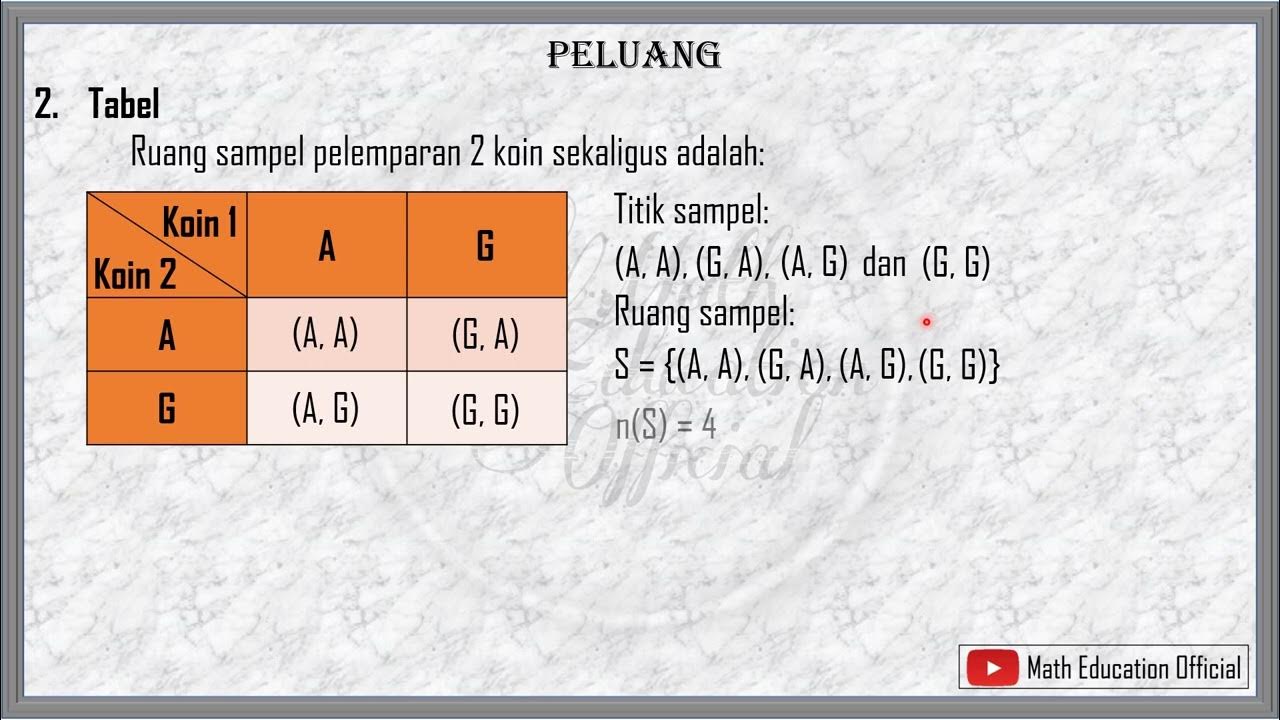RUANG SAMPEL: Mencacah Titik Sampel dengan Analisis Kombinatorik
Summary
TLDRThe video explains the concept of sample spaces and how to count the number of outcomes in probability experiments. It distinguishes between experiments with and without replacement, explaining how the sample space changes based on whether items are returned to the set after selection. The video also covers basic probability formulas such as permutations and combinations, providing examples using balls and playing cards to illustrate the concepts. It emphasizes how counting outcomes varies depending on whether order matters and offers practical advice for solving probability problems.
Takeaways
- 📊 The video explains how to calculate the number of sample points when conducting experiments with or without replacement.
- 🔄 In an experiment with replacement, previous outcomes can still appear in subsequent trials, keeping the total number of possibilities constant.
- ⚽ Example: Drawing balls from a box with replacement keeps the number of possibilities the same for each trial, leading to total possibilities being calculated as n^k.
- 🔢 In experiments with digits, repetition of numbers is allowed, and the number of possibilities is calculated based on how many digits are used and how many possibilities exist for each digit.
- 🃏 When drawing cards from a deck with replacement, the number of possibilities remains constant for each draw. For example, drawing 3 cards from a deck with replacement results in 52 * 52 * 52 possibilities.
- 🛑 Without replacement, the number of possible outcomes decreases with each trial because previously selected results are no longer possible.
- 💡 The concept of permutations is used when the order of selection matters and is calculated as n!/(n-k)!, where n is the total number of possible outcomes and k is the number of selections.
- 🔀 When order does not matter, the concept of combinations is used, calculated as n!/(k!(n-k)!), making it different from permutations.
- 🃏 In card experiments without replacement, the possibilities decrease for each draw, such as drawing 3 cards from a deck without replacement, which results in 52 * 51 * 50 possibilities.
- 📚 The video emphasizes the importance of understanding whether an experiment involves replacement or not, and if order is important, in order to apply the correct formulas for calculating the total number of outcomes.
Q & A
What is the main topic of the video?
-The video discusses how to calculate the number of possible outcomes (sample points) in experiments, focusing on cases with and without replacement in probability.
What does 'with replacement' mean in the context of probability experiments?
-'With replacement' means that after an outcome is selected in an experiment, it is returned to the sample space, allowing it to be selected again in future trials.
What formula is used to calculate the total number of possible outcomes when there is replacement?
-When there is replacement, the total number of possible outcomes is calculated using the formula n^k, where n is the number of possible outcomes in a single trial, and k is the number of trials.
How do you calculate the number of possible outcomes in an experiment without replacement?
-In an experiment without replacement, the number of possible outcomes decreases with each trial. The formula used depends on whether order matters: if order matters, you use permutations, and if not, you use combinations.
What is the difference between permutations and combinations in probability?
-Permutations take the order of outcomes into account, while combinations do not. The formula for permutations is n! / (n - k)!, and for combinations, it is n! / [k! (n - k)!], where n is the total number of outcomes and k is the number of trials.
How is the formula for permutations applied in the example with cards?
-In the example with 52 playing cards, the formula for permutations is used to calculate the total number of possible outcomes when cards are drawn without replacement, considering the order. For three cards drawn, the result is 52 × 51 × 50.
What happens to the number of possible outcomes when there is no replacement in an experiment?
-When there is no replacement, the number of possible outcomes decreases with each trial. For example, after drawing one card from a deck of 52, only 51 cards remain for the next draw.
How do combinations work in the context of drawing cards from a deck?
-Combinations are used when the order of the drawn cards doesn't matter. For example, drawing 3 cards from a deck of 52 without replacement is calculated using the combination formula, leading to fewer possible outcomes compared to permutations.
What is an example of calculating outcomes with replacement using digits?
-If you are forming a 3-digit number where digits can repeat (with replacement), and each digit can be one of 10 values (0-9), the total number of possible outcomes is 10^3 = 1000.
What is a key factor to check when determining whether to use replacement in a probability problem?
-The key factor is whether the problem explicitly states that selected items are returned to the sample space. If items are returned, the experiment uses replacement, and if not, it uses non-replacement.
Outlines

このセクションは有料ユーザー限定です。 アクセスするには、アップグレードをお願いします。
今すぐアップグレードMindmap

このセクションは有料ユーザー限定です。 アクセスするには、アップグレードをお願いします。
今すぐアップグレードKeywords

このセクションは有料ユーザー限定です。 アクセスするには、アップグレードをお願いします。
今すぐアップグレードHighlights

このセクションは有料ユーザー限定です。 アクセスするには、アップグレードをお願いします。
今すぐアップグレードTranscripts

このセクションは有料ユーザー限定です。 アクセスするには、アップグレードをお願いします。
今すぐアップグレード関連動画をさらに表示

1. RUANG SAMPEL - PELUANG - KELAS 8 SMP

MENENTUKAN RUANG SAMPEL DAN TITIK SAMPEL PELUANG PART 1

Mengenal Ruang Sampel, Titik Sampel dan Kejadian

peluang koin dan dadu

Ruang Sampel dan Peluang Suatu Kejadian (Materi dan Contoh Soal diserta Pembahasan)

Percobaan, Ruang Sampel dan Kejadian ||Materi, Soal & Pembahasan||
5.0 / 5 (0 votes)
